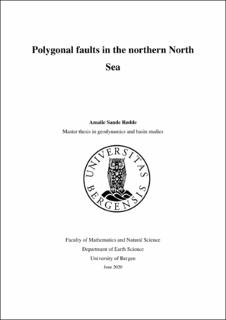Polygonal faults in the northern North Sea
Master thesis
Permanent lenke
https://hdl.handle.net/11250/2761755Utgivelsesdato
2021-06-01Metadata
Vis full innførselSamlinger
- Master theses [106]
Sammendrag
Polygonal faults have been studied in sedimentary basins at the Norwegian continental shelf and globally as non-tectonic normal faults. The polygonal faults have been recognized for a long time, but no one has described them collectively to understand the trigger mechanisms better. This study applied a 3D seismic data set of the North Viking Graben focusing on the Cenozoic sequences in the sedimentary basin. The polygonal faults in these stratigraphic sequences display a random distribution of strikes and develop in very fine-grained sediments of clays. A comprehensive seismic interpretation was conducted of the entire northern North Sea, focusing on seven sequence boundaries and six stratigraphic sequences in the period of Paleocene to Miocene. Detailed characteristics of the stratigraphic sequences were investigated by analyzing attribute maps, seismic data, and topological characteristics in minor subareas (each 56 km^2). These data were applied to examine polygonal faults distribution, seismic signatures, and geometries in the area. The most important observations in this study are: 1) the seismic expression of polygonal faults vary more between sequences than within different positions of the basin, 2) polygonal faults in the Cenozoic successions in the northern North Sea are restricted to the eastern half of the sedimentary basin. The distribution is thought to be due to reduced grain size and increased smectite content with increasing distance to the main provenance area at the East Shetland Platform, 3) the Eocene-Oligocene sequences cover the highest frequency and density of polygonal faults in the area and display evident remobilized structures of gravitational sliding from N-S trending mounds and strike sets of faults. The most evident trigger mechanism of polygonal faults in this study is an interaction between internal (dissolution, crushing, diagenesis, syneresis) and external (gravitational sliding, gravitational loading) mechanisms contributing to the formation of polygonal faults. Phases of uplift and sediments deposited from gravitational processes from the Early Paleocene to Pliocene and Pleistocene periods have impacted polygonal fault development in the basin. Late Paleocene-Early Eocene and Miocene periods are characterized by limited polygonal faults associated with uplifts, lithologies, and sand inputs.
